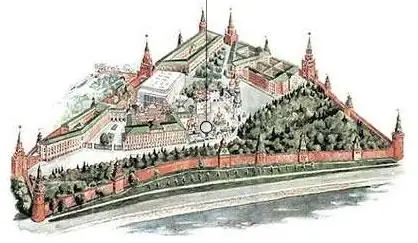- Author Harold Hamphrey [email protected].
- Public 2023-12-17 10:06.
- Last modified 2025-01-24 11:10.
Vvedensky Cathedral (Cheboksary) is a monumental architectural monument and is the main symbol of the clergy throughout the Chuvash Republic. The construction of the temple was completed in 1657. The cathedral is the only monument of the 17th century that has survived to this day. The interior decoration of the temple is striking in its splendor. The iconostasis and part of the frescoes have been preserved since the 17th-18th centuries. Of particular value is a detached bell tower. And although it has been repaired more than once, the main outlines have been preserved in their original form to our time.
History

On May 26, 1555, the Russian Tsar Ivan IV the Terrible adopted a decree, having previously received the blessing of Metropolitan Macarius of Moscow, that the Archbishop of Kazan and Sviyazhsky Gury began to hold services in Cheboksary and built a church there. The next day, Gury and his close companions went to the newly opened Kazan diocese. In allvillages, which the ministers passed, met them with a magnificent celebration and procession.
At the end of July 1555, the archbishop and his companions arrived at the place where the city of Cheboksary should have been. The first order given by Gury was the erection of a cathedral church on the top of the mountain. He himself installed a linen camp church here and sprinkled the surroundings of the future city with holy water, thereby marking its horizons. Vvedensky Cathedral (Cheboksary) became the basis for the creation of the city.
In the field church of Guria there was the only icon of the Mother of God. The Archbishop celebrated her first Divine Liturgy. After that, all residents could receive the blessing of the Virgin. The icon of the Most Pure Mother of God of Vladimir with the baby is still located on the territory of the cathedral and is the most important and revered shrine of the temple.
Start of construction
Later the canvas church was replaced by a wooden cathedral. Almost nothing is known about the interior of the temple. In the center stood a small iconostasis. The main object of worship was the icon of the Mother of God of Vladimir. There were also several icons of Stroganov's letters. Church utensils consisted of two chalices, one of which was donated by Archbishop Guriy, and the other was brought from Persia. Inside the temple was decorated with wooden crowns. One of the walls was decorated with an image of an angel with a casket filled with the relics of saints, carved into the wall. Virtually none of the above was saved.
Interior decoration

BIn 1651, a stone cathedral was erected on the same spot. It was supposedly consecrated by the Metropolitan of Kazan Kornily I. At first, only a cold church was built with the throne of the Entry of the Most Holy Theotokos into the temple. Later, in 1657, warm outbuildings dedicated to St. Sergius of Radonezh and St. Alexis were completed. Near the temple a bell tower was erected in the form of a tent. The Vvedensky Cathedral at that time was built of brick and rubble stone. It was built by local masons, who were led by Nizhny Novgorod masters. They decided to paint the walls and vaults with images of saints. They also depicted events from the New Testament. At that time it was the only stone building in the city. The Vvedensky Cathedral (Cheboksary) survived many difficulties. His story is unusual.
Later, services in the temple had to be suspended, and the cathedral itself had to be closed. But already in 1943 services resumed again. In 1945, the rector of the temple donated a large sum to the defense fund. With this money, a tank column of Dmitry Donskoy was built.
Until 1985, there was a museum of local lore within the limits of Alexy and Kharlampy the holy martyr.
Temple today

Vvedensky Cathedral (Cheboksary) has undergone major repairs more than once during its existence. Nevertheless, its original appearance has been preserved to this day. Of course, there were still small losses. For example, the first tier of the facade was walled up over time with outbuildings of the vestibule.
The interior of the temple is decorated with frescoes,belonging to the era of classicism. The iconostasis is also made in this style. The belfry in the form of a tent belongs to the architecture of the 18th century. It was also rebuilt many times, but retained its original shape.
Vvedensky Cathedral (Cheboksary) became the burial place for two bishops of Cheboksary - Ilarius and Benjamin.
Temple shrines

A particularly revered icon of the Vvedensky Cathedral was and remains the icon of the Mother of God of Vladimir. Today it is framed with a silver and gold riza. The shrine is located to the left of the royal gate.
Also, other, no less significant shrines appeared in the cathedral. The icon of Christ the Savior was presented to the cathedral by Metropolitan Tikhon of Kazan and Sviyazhsk. The icon is framed with silver and pearls. In 1687, the Georgian Tsar Archil presented Metropolitan Tikhon with the image of the Mother of God of Smolensk, which he, in turn, presented to the Vvedensky Cathedral. Pieces of the relics of the holy Archbishop Guria and his original companions were placed in silver pockets and placed in the icon.
Incredibly beautiful Vvedensky Cathedral (Cheboksary). The photo cannot fully convey its greatness.






